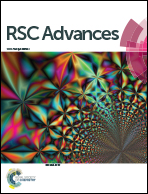Retrieval of CO2 from a carbonate solution for its sequestration by a novel electrochemical decarbonizing and ingathering method†
Abstract
Many attempts at CO2 recovery and sequestration have been made in recent years. The use of an electrochemical decarbonizing and ingathering method exhibits the ability to segregate targeted ions absorbed in a dilute solution. However, because of the low conductivity of the dilute solution, a great part of the energy is consumed to overcome the internal resistance. In this study, an “electro-dynamic inspissation (EDI)” system was introduced to examine the retrieval of carbonate ions from a sodium carbonate solution. The addition of an ion exchange resin serving as a conductor in the EDI device provides a new way to enable CO2 recovery from the concentrated stream; thus, a purified CO2 stream was obtained. The properties of the EDI system were characterized in detail, addressing its recovery effectiveness and providing a cost evaluation. The results indicate that EDI performs well, with the current efficiency reaching 75% and the energy consumption calculated as 1.41 MJ kg−1 of CO2 captured. This system is an alternative to most traditional technologies, such as amine absorption/thermal desorption.


 Please wait while we load your content...
Please wait while we load your content...